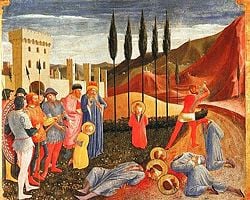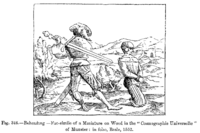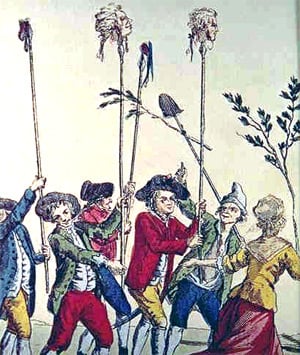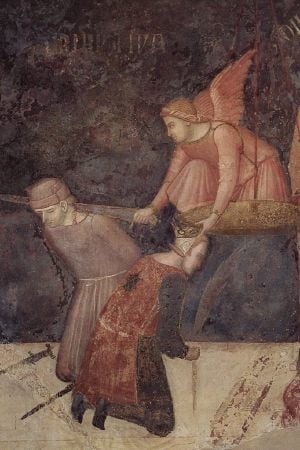Difference between revisions of "Beheading" - New World Encyclopedia
| Line 10: | Line 10: | ||
The word '''decapitation''' can also refer, on occasion, to the removal of the head from a [[body]] that is already dead. This might be done to take the head as a [[headhunting|trophy]], for [[gibbet|public display]], to make the deceased more difficult to identify. | The word '''decapitation''' can also refer, on occasion, to the removal of the head from a [[body]] that is already dead. This might be done to take the head as a [[headhunting|trophy]], for [[gibbet|public display]], to make the deceased more difficult to identify. | ||
| − | |||
In an analogous fashion, decapitation can also refer to the removal of the head of an organization. If, for example, the leader of a country were killed, that might be referred to as "decapitation." | In an analogous fashion, decapitation can also refer to the removal of the head of an organization. If, for example, the leader of a country were killed, that might be referred to as "decapitation." | ||
| Line 57: | Line 56: | ||
==Decapitation in the Twenty-first Century== | ==Decapitation in the Twenty-first Century== | ||
| − | Decapitation by sword has in modern times occurred in [[jurisdiction]]s subject to [[Islam]]ic [[Sharia]]. [[Saudi Arabia]], [[Yemen]], and [[Qatar]] all allow decapitation as a form of [[capital punishment]], but only Saudi Arabia practices it: a curved, single-edged sword is used, in public. Saudi Arabian authorities beheaded four men in February 2007—four [[Sri Lanka]]n workers were convicted in a Saudi Arabian court for an armed [[robbery]] committed in October 2004. Their deaths sparked reactions from the international [[human rights]] watchdog [[Amnesty International]], which called on the Saudi authorities to abolish the death sentence. The court also ruled that the bodies of the four workers be publicly displayed as an example for others.<ref>[http://www.bbc.co.uk/sinhala/news/story/2007/02/070223_saudi_hrw.shtml Sri Lankans 'crucified' in Riyadh] BBC. Retrieved May 2, 2007.</ref> | + | Decapitation by sword has in modern times occurred in [[jurisdiction]]s subject to [[Islam]]ic [[Sharia]]. [[Saudi Arabia]], [[Yemen]], and [[Qatar]] all allow decapitation as a form of [[capital punishment]], but only Saudi Arabia practices it: a curved, single-edged sword is used, in public. Saudi Arabian authorities beheaded four men in February 2007—four [[Sri Lanka]]n workers were convicted in a Saudi Arabian court for an armed [[robbery]] committed in October 2004. Their deaths sparked reactions from the international [[human rights]] watchdog [[Amnesty International]], which called on the Saudi authorities to abolish the death sentence. The court also ruled that the bodies of the four workers be publicly displayed as an example for others.<ref>[http://www.bbc.co.uk/sinhala/news/story/2007/02/070223_saudi_hrw.shtml Sri Lankans 'crucified' in Riyadh] ''BBC''. Retrieved May 2, 2007.</ref> |
Militant Islamic groups have carried out so-called "beheadings" with small knives, some as small as pocket knives. Unusually, these "beheadings" begin with cutting the throat, then slowly hacking away at the spine. Historically, most methods of beheading use a heavy, sharp steel blade, cutting through the neck from behind, which quickly severs the spine, then cuts the blood vessels, trachea, and esophagus: a single stroke usually suffices. The frontal approach more closely resembles ''Dhabiĥa'', a method used to slaughter animals, thereby rendering the meat [[hallal]], in which the goal is to drain all the blood from the animal as quickly as possible. Ritual slaughter of this kind does not require decapitation; only the draining of all the blood. | Militant Islamic groups have carried out so-called "beheadings" with small knives, some as small as pocket knives. Unusually, these "beheadings" begin with cutting the throat, then slowly hacking away at the spine. Historically, most methods of beheading use a heavy, sharp steel blade, cutting through the neck from behind, which quickly severs the spine, then cuts the blood vessels, trachea, and esophagus: a single stroke usually suffices. The frontal approach more closely resembles ''Dhabiĥa'', a method used to slaughter animals, thereby rendering the meat [[hallal]], in which the goal is to drain all the blood from the animal as quickly as possible. Ritual slaughter of this kind does not require decapitation; only the draining of all the blood. | ||
| − | Less orthodox instances of decapitation have also occurred in some areas of [[Colombia]]. [[Marxism|Marxist]] [[Revolutionary Armed Forces of Colombia|FARC]] [[guerrilla warfare|guerrilla]] as well as right-wing paramilitary groups such as the [[United Self-Defense Forces of Colombia|AUC]] have sometimes used this method to intimidate local populations and political opponents, and it has not been uncommon for criminal gangs of druglords to also make limited use of decapitation on occasion. In 2006, a [[drug war]] carried out by [[Mexico]]'s new president, [[Felipe Calderón]], against druglords and various other criminals caused many beheadings by those druglords in retaliation. The heads were then reportedly tossed into a nightclub and placed in front of various other government buildings accompanied with notes of warning from the druglords.<ref>[http://news.bbc.co.uk/1/hi/world/americas/6563051.stm Mexico drugs cartels feud erupts] BBC. Retrieved May 2, 2007.</ref> The primary means of decapitation in these cases has been the use of a [[machete]] or [[chainsaw]]. | + | Less orthodox instances of decapitation have also occurred in some areas of [[Colombia]]. [[Marxism|Marxist]] [[Revolutionary Armed Forces of Colombia|FARC]] [[guerrilla warfare|guerrilla]] as well as right-wing paramilitary groups such as the [[United Self-Defense Forces of Colombia|AUC]] have sometimes used this method to intimidate local populations and political opponents, and it has not been uncommon for criminal gangs of druglords to also make limited use of decapitation on occasion. In 2006, a [[drug war]] carried out by [[Mexico]]'s new president, [[Felipe Calderón]], against druglords and various other criminals caused many beheadings by those druglords in retaliation. The heads were then reportedly tossed into a nightclub and placed in front of various other government buildings accompanied with notes of warning from the druglords.<ref>[http://news.bbc.co.uk/1/hi/world/americas/6563051.stm Mexico drugs cartels feud erupts] ''BBC''. Retrieved May 2, 2007.</ref> The primary means of decapitation in these cases has been the use of a [[machete]] or [[chainsaw]]. |
| − | The militant Islamic separatist group [[Abu Sayyaf]] is known to practice beheading in the southern islands of the [[Philippines]].<ref>[http://www.cfr.org/publication/9235/ Abu Sayyaf Group (Philippines, Islamist separatists)] Council on Foreign Relations. Retrieved May 2, 2007.</ref> | + | The militant Islamic separatist group [[Abu Sayyaf]] is known to practice beheading in the southern islands of the [[Philippines]].<ref>[http://www.cfr.org/publication/9235/ Abu Sayyaf Group (Philippines, Islamist separatists)] ''Council on Foreign Relations''. Retrieved May 2, 2007.</ref> |
| − | Beheadings are also reportedly practiced by the [[El Salvador]]an [[street gang]] [[Mara Salvatrucha]], which operates in the [[United States]] and [[Latin America]].<ref>[http://msthirteen.com/2006/06/30/breaking-news.aspx More human heads found in Acapulco] MS13 News & Analysis. Retrieved May 2, 2007.</ref> | + | Beheadings are also reportedly practiced by the [[El Salvador]]an [[street gang]] [[Mara Salvatrucha]], which operates in the [[United States]] and [[Latin America]].<ref>[http://msthirteen.com/2006/06/30/breaking-news.aspx More human heads found in Acapulco] ''MS13 News & Analysis''. Retrieved May 2, 2007.</ref> |
| − | In Southern [[Thailand]], there were at least 15 cases where [[Buddhists]] have been beheaded. Thai officials suspect the attackers were [[Islamic extremist terrorism|Islamist extremists]] who are seeking to separate the Muslim-dominated south from the rest of Thailand.<ref>[http://english.aljazeera.net/NR/exeres/4957FE9D-F720-4F34-90E5-3CD033B24F5C.htm Thai Buddhist found decapitated] Al Jazeera. Retrieved May 2, 2007.</ref> | + | In Southern [[Thailand]], there were at least 15 cases where [[Buddhists]] have been beheaded. Thai officials suspect the attackers were [[Islamic extremist terrorism|Islamist extremists]] who are seeking to separate the Muslim-dominated south from the rest of Thailand.<ref>[http://english.aljazeera.net/NR/exeres/4957FE9D-F720-4F34-90E5-3CD033B24F5C.htm Thai Buddhist found decapitated] ''Al Jazeera''. Retrieved May 2, 2007.</ref> |
== Famous Beheadings== | == Famous Beheadings== | ||
Revision as of 04:53, 28 May 2007

Decapitation or beheading, is the removal of the head from a living body. Beheading typically refers to the act of intentional decapitation, such as a means of murder or execution. It may be accomplished, for example, with an axe, sword, or knife, or by means of a guillotine.
Definition
Decapitation (from Latin, caput, capitis, meaning head), or beheading, is the removal of a living organism's head. Beheading typically refers to the act of intentional decapitation, such as a means of murder or execution. It may be accomplished, for example, with an axe, sword, or knife, or by means of a guillotine. Accidental decapitation can be the result of an explosion, automobile or industrial accident, improperly-administered execution by hanging or other violent injury. Suicide by decapitation is rare, but not unknown. Decapitation is always fatal, as brain death occurs within seconds to minutes without the support of the organism's body. There is no way to provide life support for a severed head with current medical techniques.
The word decapitation can also refer, on occasion, to the removal of the head from a body that is already dead. This might be done to take the head as a trophy, for public display, to make the deceased more difficult to identify. In an analogous fashion, decapitation can also refer to the removal of the head of an organization. If, for example, the leader of a country were killed, that might be referred to as "decapitation."
History
Decapitation has been used as a form of capital punishment for millennia. The terms "capital offense," "capital crime," and "capital punishment" derive from the punishment for serious offenses being the removal of the criminal's head.
In biblical record, John the Baptist was beheaded after being imprisoned by Herod Antipas, whom he had reproved for taking his brother Philip's wife Herodias (Luke 3:19). Herod had married Herodias contrary to the Mosaic Law and John vehemently protested this, which led to his arrest. When Herod made an oath in the presence of his guests to reward Heorodias' daughter for the excellence of her dancing before the crowd, it provided an excuse to murder John. Herod promised to grant Heorodias' daughter Salome whatever she might ask. Prompted by her mother, Salome requested the head of John the Baptist on a platter:
And she went out, and said to her mother, “What shall I ask?” And she said, “The head of John the Baptizer.” And she came in immediately with haste to the king, and asked, saying “I want you to give me at once the head of John the Baptist on a platter.” (Mark 6:24-26)
Political prisoners (traitors) and serious criminals often had their heads removed and placed on public display for a period of time. For instance, in medieval England, the heads were placed on spikes along the walls of the Tower of London.
Execution by beheading with a sword (or axe) was sometimes considered the "honorable" way to die for an aristocrat, who, being warriors, could often expect to die by the sword. In England it was considered the privilege of noblemen to be beheaded. This was distinguished from a "dishonorable" death by hanging on the gallows or through burning at the stake. High Treason by nobles was punished by beheading; male commoners, including knights, were hanged, drawn, and quartered; female commoners were burned at the stake.
If the headsman's axe or sword was sharp and his aim was true, decapitation was a quick and thought to be a relatively painless form of death. If the instrument was blunt or the executioner clumsy, however, multiple strokes might be required to sever the head. The person to be executed was therefore advised to give a gold coin to the headsman so that he did his job with care. However, Robert Devereux, 2nd Earl of Essex and Mary I of Scotland required three strikes at their respective executions.
It is of note that in the biblical Book of Revelation, beheading is named as a method of execution of Christian martyrs during a great persecution (Rev. 20:4). There is no historical record of precisely such an event, so certain commentators believe that this verse refers to a last great persecution of the church that some Christians believe will occur shortly before the Second Coming of Christ. The early Christians considered the Second Coming imminent, for which reason many refused to marry or procreate, and some gave away all their possessions.
Decapitation Around the World
Britain
William the Conqueror was the first to use beheading in Britain, executing Waltheof, Earl of Northumberland in 1076. The punishment was reserved for members of the royal family who committed such high crimes as treason or murder. Most of the beheadings took place in London Tower. The last instance of beheading in England took place in 1747 with the execution of Simon Lord Lovatt.
China
In traditional China, decapitation was considered a more severe form of punishment than strangulation, although strangulation caused more-prolonged suffering. Strangulation was preferred because the Chinese believed that their bodies were gifts from their parents, and that it was therefore disrespectful to their ancestors to return their bodies to the grave dismembered. The Chinese had other punishments, such as the "lingering death," that involved cutting the body into multiple pieces.
France
Decapitation by guillotine was a common, mechanically-assisted form of execution, invented shortly before the French Revolution (although earlier versions such as the Scottish "Maiden" and the English "Halifax Gibbet" were used earlier). The guillotine was designed was to create a painless and quick form of execution that did not require great skill to carry out.
The executioner would hold the severed head up to the crowd. It was believed (with dubious evidence) that the head could still see for around ten seconds. The French had a strict code of etiquette surrounding the executions. A man named Legros, one of the assistants at the execution of Charlotte Corday, was imprisoned and dismissed for slapping the face of the victim after the blade had fallen in order to see whether any flicker of life remained (witnesses say that it flushed as though angry, although with no blood circulation possible, this "evidence" is likely false). While the idea of showing the dying head the reaction of the crowd or their own dead body is perhaps not beyond the cruelty of the revolutionaries, it would certainly go against the "humane" spirit in which the guillotine was introduced and applied.
The guillotine was used in France during the French Revolution and remained the normal judicial method in peace time, in use until the abolition of the death penalty in France in 1981. (The guillotine was also used in Algeria before the French lost control of it, as shown in the Gillo Pontecorvo's film The Battle of Algiers. Another guillotine existed in the Vatican City until recent years. It had been brought in by Napoleon's forces during the early nineteenth century; and in 1870, the Pope still claimed the authority to use it. The Vatican has abolished capital punishment in its own jurisdiction, and recent Popes have condemned capital punishment where it is still practiced.
Germany
Many German states had used a guillotine-like device known as a Fallbeil since the seventeenth and eighteenth centuries, and decapitation by guillotine was the usual means of execution in Germany until the abolition of the death penalty in Germany in 1949. In Nazi Germany, the guillotine was reserved to criminal convicts. It is estimated some 40,000 persons were guillotined in Germany and Austria between 1933 and 1945. This number includes resistance fighters both in Nazi Germany itself and in those countries that were occupied by them. As these resistance fighters were not part of any regular army they were considered common criminals and were in many cases taken to Germany and decapitated. Decapitation was considered a "dishonorable" death, unlike an "honorable" death, such as execution by firing squad.
Japan
In Japan, decapitation was a common punishment, sometimes for minor offenses. In addition, decapitation was historically performed as the second step in seppuku (ritual suicide by disembowelment). After the victim had sliced his own abdomen open, another warrior, a selected attendant (kaishakunin) or second, would strike his head off from behind with a sword to hasten death and to reduce the suffering. The blow was expected to be precise enough to leave intact a small strip of skin at the front of the neck - to spare invited and honored guests the indelicacy of witnessing a decapitated head rolling about, or towards them, whilst spraying blood. Such an event would have been considered inelegant and in bad taste. The sword was expected to be used upon the slightest sign that the practitioner might yield to pain and cry out - avoiding dishonor to him, and to all partaking in the privilege of observing an honorable demise. As skill was involved, only the most trusted warrior was honored enough to take part as the second. The second was usually, but not always, a friend. If a defeated warrior had fought honorably and well, an opponent who wanted to salute his bravery would volunteer to act as his second.
In Scandinavia, decapitation was the usual means of carrying out capital punishment. Noblemen were beheaded with a sword, and commoners with an axe. The last executions by decapitation in Finland in 1825 and Norway in 1876 were carried out with axes. The same was the case in Denmark in 1892. The last decapitation in Sweden in 1910 was carried out with a guillotine.
Decapitation in the Twenty-first Century
Decapitation by sword has in modern times occurred in jurisdictions subject to Islamic Sharia. Saudi Arabia, Yemen, and Qatar all allow decapitation as a form of capital punishment, but only Saudi Arabia practices it: a curved, single-edged sword is used, in public. Saudi Arabian authorities beheaded four men in February 2007—four Sri Lankan workers were convicted in a Saudi Arabian court for an armed robbery committed in October 2004. Their deaths sparked reactions from the international human rights watchdog Amnesty International, which called on the Saudi authorities to abolish the death sentence. The court also ruled that the bodies of the four workers be publicly displayed as an example for others.[1]
Militant Islamic groups have carried out so-called "beheadings" with small knives, some as small as pocket knives. Unusually, these "beheadings" begin with cutting the throat, then slowly hacking away at the spine. Historically, most methods of beheading use a heavy, sharp steel blade, cutting through the neck from behind, which quickly severs the spine, then cuts the blood vessels, trachea, and esophagus: a single stroke usually suffices. The frontal approach more closely resembles Dhabiĥa, a method used to slaughter animals, thereby rendering the meat hallal, in which the goal is to drain all the blood from the animal as quickly as possible. Ritual slaughter of this kind does not require decapitation; only the draining of all the blood.
Less orthodox instances of decapitation have also occurred in some areas of Colombia. Marxist FARC guerrilla as well as right-wing paramilitary groups such as the AUC have sometimes used this method to intimidate local populations and political opponents, and it has not been uncommon for criminal gangs of druglords to also make limited use of decapitation on occasion. In 2006, a drug war carried out by Mexico's new president, Felipe Calderón, against druglords and various other criminals caused many beheadings by those druglords in retaliation. The heads were then reportedly tossed into a nightclub and placed in front of various other government buildings accompanied with notes of warning from the druglords.[2] The primary means of decapitation in these cases has been the use of a machete or chainsaw.
The militant Islamic separatist group Abu Sayyaf is known to practice beheading in the southern islands of the Philippines.[3]
Beheadings are also reportedly practiced by the El Salvadoran street gang Mara Salvatrucha, which operates in the United States and Latin America.[4]
In Southern Thailand, there were at least 15 cases where Buddhists have been beheaded. Thai officials suspect the attackers were Islamist extremists who are seeking to separate the Muslim-dominated south from the rest of Thailand.[5]
Famous Beheadings
- John the Baptist in the Gospels
- Saint Alban (around 304)
- Sir William Wallace, (1305)
- Saint Thomas More (1535)
- Anne Boleyn (1536)
- Thomas Cromwell, 1st Earl of Essex (1540)
- Lady Jane Grey (1554)
- Mary, Queen of Scots (1587)
- Ishida Mitsunari (1600)
- Sir Walter Raleigh (1618)
- Oliver Cromwell (1661) Although already dead, he was beheaded by order of Charles II
- Marie Antoinette (1793)
- Georges Danton (1794)
- Antoine Lavoisier (1794)
- Maximilien Robespierre (1794)
Notes
- ↑ Sri Lankans 'crucified' in Riyadh BBC. Retrieved May 2, 2007.
- ↑ Mexico drugs cartels feud erupts BBC. Retrieved May 2, 2007.
- ↑ Abu Sayyaf Group (Philippines, Islamist separatists) Council on Foreign Relations. Retrieved May 2, 2007.
- ↑ More human heads found in Acapulco MS13 News & Analysis. Retrieved May 2, 2007.
- ↑ Thai Buddhist found decapitated Al Jazeera. Retrieved May 2, 2007.
ReferencesISBN links support NWE through referral fees
- Abbott, Geoffrey. 2000. Whos Who Of British Beheadings. Andre Deutsch. ISBN 0233997741
- Abbott, Geoffrey. 2003. Severed: British Beheadings Through the Ages. Andre Deutsch. ISBN 0233051279
- Jones, Regina. 2005. Losing Our Heads: Beheadings in Literature and Culture. New York University Press. ISBN 0814742696
- Stahl, Paul H. 1986. Histoire de la décapitation. Presses universitaires de France. ISBN 2130392121
External links
- Beheading Retrieved May 3, 2007.
Credits
New World Encyclopedia writers and editors rewrote and completed the Wikipedia article in accordance with New World Encyclopedia standards. This article abides by terms of the Creative Commons CC-by-sa 3.0 License (CC-by-sa), which may be used and disseminated with proper attribution. Credit is due under the terms of this license that can reference both the New World Encyclopedia contributors and the selfless volunteer contributors of the Wikimedia Foundation. To cite this article click here for a list of acceptable citing formats.The history of earlier contributions by wikipedians is accessible to researchers here:
The history of this article since it was imported to New World Encyclopedia:
Note: Some restrictions may apply to use of individual images which are separately licensed.



